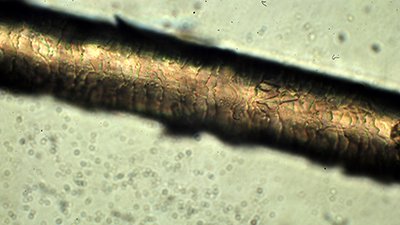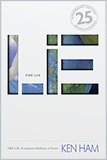Cold-Blooded or Warm-Blooded?
Study proves growth rings in bone cannot be used to determine whether an animal is cold-blooded or warm-blooded.
News Sources
In an effort to determine whether bone “growth rings” vary in thickness seasonally in mammals as they do in cold-blooded animals, investigators have invalidated the standard interpretation of a clue to dinosaur thermophysiology. Were dinosaurs cold-blooded or warm-blooded? Without living dinosaurs to examine, paleontologists can only guess on the basis of indirect clues in the fossilized bones.
“We did not design it [the study] to find a response to the thermophysiology of dinosaurs,” explained lead author Meike Köhler of Spain’s Catalan Institute of Paleontology. “We sought to better understand the physiology of extant mammals and how the environment affects them—how their growth changes as a result of external temperatures, rain and the availability of food and water.” But soon the research team realized its work was relevant to the dinosaur question.
These growth rings are complex concentric layers surrounding blood vessels in dense compact bone. Such rings are found in both cold-blooded and warm-blooded vertebrates. “Cold-blooded” animals are more accurately called ectothermic, because their body temperature is controlled by the environment outside their bodies (hence, ecto-) and may be cold or hot. “Warm-blooded” animals are endothermic, their body temperature being internally (endo-) controlled.
These concentric bony layers may be evenly spaced or vary in thickness, like tree rings. The rings in cold-blooded (ectothermic) reptiles and amphibians typically have thin “lines of arrested growth” (LAGs) thought to form during seasonal times of dryness and deprivation due to metabolic slowing. Without much data, scientists have previously assumed warm-blooded (endothermic) animals would have evenly spaced rings without LAGs due to their ability to maintain the high metabolic rate required to control their own body temperature despite seasonal variations.
It may seem surprising that until now there has not been a similar systematic study to prove or disprove whether it is only ectotherms that leave these marks in their bones during growth.
“It may seem surprising that until now there has not been a similar systematic study to prove or disprove whether it is only ectotherms that leave these marks in their bones during growth,” Köhler said.
Her team studied the thigh bones of 115 wild ruminants of various sizes from a variety of ecosystems all over the world. They found, to the surprise of many, that all these endothermic mammals, exposed to seasonal variations, have LAGs just like ectotherms. They also confirmed that metabolic rate varies seasonally even in endothermic animals and does correlate with the bony rings. Therefore, one of the key bits of evidence previously believed to show most dinosaurs were cold-blooded (ectothermic)—the presence of LAGs in all types of dinosaurs except sauropods1—is no longer valid.
“The first finding of a LAG in a dinosaur (in the 1980s by Reid, published in Nature) has led to the conviction that dinosaurs are ectotherms,” said Köhler. “Our findings that LAGs are consistently present in large homeothermic mammals (ruminants) of all ecosystems and under all climatic conditions falsifies this argument.”
In addition to the LAGs, this study confirms the correlation between the time of rapid growth, high metabolic rate, and the corresponding highly vascularized portion of the bony rings. Since these highly vascularized areas are also seen in dinosaur bones, U.C.–Berkeley paleontologist Kevin Padian explains, “The [dinosaur] bone growth patterns . . . establishes [sic] that they grew just like large mammals do, and at comparable rates. So their physiology could not have been like lizards and crocodiles, which grow much more slowly and whose bones look very different inside.” Also commenting on the research, Florida State’s Gregory Erikson says, “This is a fantastic paper, it provides the much needed background work that should have been done in the first place. Paleohistologists have been viewing dinosaur bones all wrong by assuming they show a mix of reptilian (growth lines) and avian/mammalian traits (highly vascularised woven bone). This remarkably thorough study shows that dinosaur bones are more like those of endothermic animals than anyone realised.”
But does this information demonstrate dinosaurs were warm-blooded (endothermic)? No. What this information demonstrates is that the presence of LAGs in bone cannot be used to determine whether an organism is endothermic or ectothermic. And it does demonstrate that there truly is a correlation between high metabolic rate, rapid growth, and highly vascularized bone. Thus, we might reasonably surmise that at least some dinosaurs had a high metabolic rate and were capable of rapid growth. Perhaps, we also might surmise, this rapid growth potential enabled large dinosaurs to reach their gigantic sizes in reasonably short timespans.
Paleontologist Padian commented, “Actually there never was any evidence that dinosaurs were ectotherms. It was just sort of like, well, dinosaurs are reptiles, and living reptiles are cold-blooded . . . so dinosaurs were cold-blooded.” Evolutionists who are determined to believe birds evolved from dinosaurs very much want to show dinosaurs were endothermic because birds are endothermic. But even if dinosaurs were more endothermic than living reptiles, would that prove dinosaurs evolved into birds? No. It would only illustrate more of the created variety in the world God created.
From a creationist perspective, the endothermic/ectothermic question for the dinosaurs has no particular ramifications. While evolutionists insist that endotherms evolved from ectotherms, we simply maintain that God created both endotherms and ectotherms during Creation Week about 6,000 years ago. God’s eyewitness account in Genesis tells us that He created animals to reproduce after their kinds, and no animal kinds have ever been proven to evolve into other kinds nor is there any known mechanism by which one kind of animal can acquire the new genetic information to become a new kind of animal. Warm-blooded birds were created the day before land animals, including dinosaurs, whatever their metabolism and their thermophysiology were like.
Further Reading
For More Information: Get Answers
Remember, if you see a news story that might merit some attention, let us know about it! (Note: if the story originates from the Associated Press, FOX News, MSNBC, the New York Times, or another major national media outlet, we will most likely have already heard about it.) And thanks to all of our readers who have submitted great news tips to us. If you didn’t catch all the latest News to Know, why not take a look to see what you’ve missed?
(Please note that links will take you directly to the source. Answers in Genesis is not responsible for content on the websites to which we refer. For more information, please see our Privacy Policy.)
Footnotes
- M. Köhler, “Seasonal bone growth and physiology in endotherms shed light on dinosaur physiology,” Nature published online 27 June 2012 doi:10.1038/nature11264 www.nature.com/nature/journal/vaop/ncurrent/full/nature11264.html and paleobiol.geoscienceworld.org/content/34/2/247.short.
Recommended Resources

Answers in Genesis is an apologetics ministry, dedicated to helping Christians defend their faith and proclaim the good news of Jesus Christ.
- Customer Service 800.778.3390
- © 2024 Answers in Genesis








